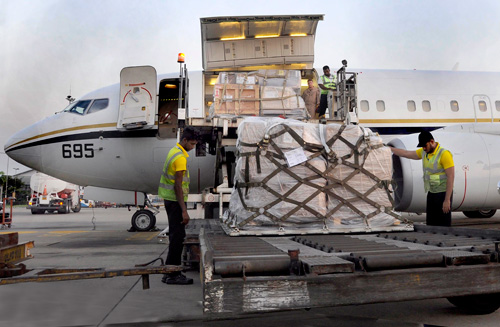News
US Navy trials Temporary Cargo Transport Initiative
The US Navy carried out its third cargo transfer out of Bandaranaike International Airport (BIA) this week, using two C-2 Greyhound carrier borne transport aicraft and a US Navy C-40 transport aircraft to fly in supplies to US aircraft carrier USS John C Stennis which was anchored in international waters off Sri Lanka.

Personal goods for sailors, spare parts, tools, mail are brought on one aircraft, then transported on another to a ship at sea. Pic by Ishanka Sunimal
It follows two successful transfers that took place, in August 2018 and December 2018, at the BIA and Trincomalee airports. The media were invited to observe. The ‘air logistics hub’ was first operated in August when USS Anchorage (LPD 23) visited Trincomalee and supported the Essex Amphibious Ready Group as it transited the Western boundary of the 7th Fleet area of operations. This week’s operation saw the moving of supplies that came from Bahrain to the US aircraft carrier USS John C Stennis using the Greyhounds from the VCR-30 Squadron, The Providers.
The C-40 transport aircraft flew in the cargo and the two Greyhounds flew into BIA, transferred the supplies onboard and returned to the carrier.
“These transactions have contributed approximately 31 million Sri Lankan rupees to the local economy,” the US Embassy said. The operation is called a Temporary Cargo Transport Initiative (TCTI). The US Pacific Fleet first issued a press release in December announcing that aircraft carrier USS John C Stennis has set up a logistics hub in Sri Lanka “to receive support, supplies and services at sea. ”
The world’s largest fleet command, the US Pacific Fleet covers 100 million square miles and has approximately 200 ships and submarines, nearly 1,200 aircraft, and more than 130,000 sailors and civilians.
“What happens is that supplies and cargo such as fuel, personal goods for sailors, paper goods, spare parts, tools, mail, etcetera, are brought on an aircraft that lands in Sri Lanka,” explained a diplomatic source. “Another aircraft comes from a ship out at sea, takes the cargo unloaded by the first aircraft, and returns to the ships that transit the Indian Ocean between East Asia and the Middle East.
“The concept is that an aircraft would depart a passing ship, land in Sri Lanka in an airstrip provided (prior clearance is obtained from the relevant Sri Lankan authorities), pick-up cargo, and return to the ship,” the source said. “Therefore, what Sri Lanka provided in the exercise described was a temporary facility for an aircraft to land with supplies, and clearance for the other aircraft to come in and take the supplies and return to the US ship. It was not a facility to establish a US naval base as described in speculative media reports.”
“The temporary air logistics hub concept allows for the use of an airstrip and storage facilities to receive large-scale shipments to move out in various directions in smaller shipments, allowing ships to continue operating at sea by receiving the right material at the right place and time,” the US Pacific Fleet press release said separately. “The hub can also be established to provide expeditionary logistics support during humanitarian and disaster relief missions.”
Bimal Ratnayake, JVP MP, recently asked in Parliament for the Sri Lankan Government’s stance on US naval aircraft landing in commercial airports here. The rumours prompted the US Embassy in Colombo to categorically deny they were seeking to establish a military base in Sri Lanka. “Reports that the United States seeks to establish a military base in Sri Lanka are categorically false,” the US embassy said.
TCTI transactions are also known as temporary air logistics operations. They promote Sri Lanka’s efforts to become a regional hub for logistics and commerce, a US Embassy press release said. They are a series of commercial transactions conducted in coordination with the Government of Sri Lanka, which is fully apprised of all US aircraft arrivals and departures, an Embassy spokesperson said. They involve the transport of non-lethal cargo such as spare parts, mail, and paper goods.
There are no foreign personnel based in Sri Lanka for this, a Foreign Ministry source said, pointing out that when an operation happens, it does so under existing laws and regulations. The US obtains prior approval from the Ministry of Foreign Affairs (MoFA), the Ministry of Defence (MoD), Civil Aviation Authority and relevant stakeholders.
The three TCTI transactions so far have been trials by the US Navy. “There are plans to develop a standard operations procedure (SOP) or draft a MoU to streamline and better process such temporary logistics operations in a more effective manner in the future,” the MoFA source said.
The US Navy personnel who flew the carrier-borne Greyhounds said such operations gave them an opportunity to build relationships with their Sri Lankan counterparts, enabling better cooperation and understanding in times of natural disaster and humanitarian assistance operations.

